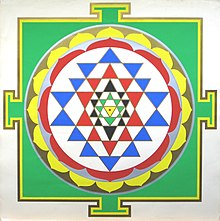What is Tantra?
 Updated 10/16
Updated 10/16
Most people think of sexual orgies when they hear the word, Tantra. At least I did. Because it has been popularized in the West as a scene for singles to hook up and explore their sexuality, the common Western understanding of Tantra has gotten pretty skewed. So let’s look at what Tantra really is.
Tantra Defined:
One definition of Tantra is: A technology for the expansion of Consciousness.
Another definition: a spiritual text comprising a system of Tantrik practices.
Tantra is rooted in ancient spiritual teachings and body-based practices guiding a seeker to achieve liberation from suffering while embodied. Liberation is Union with the Divine; an experience of Oneness and Wholeness with everything. This is the freedom that comes from not fighting with reality. It is a resting into our inherent Essence-nature of peace and presence.
The Roots of Tantra:
Tantra arose in India around 600 – 800 CE as a reaction to the more conservative yoga of the time (the Upanishads and later, the Yoga Sutra). It is a type of yoga. But instead of insisting the yogi must transcend the body and the mundane through ascetic practices, Tantra embraced the body as a vehicle for transformation and saw worldly endeavors as potential portals to liberation. Tantra welcomed all castes and genders to partake instead of just upper caste males. And Tantra in it’s non-dual form, recognized everything as Divine and whole, with the goal as complete recognition of one’s wholeness and oneness with everything. Modern postural yoga, which stems from Hatha yoga, is rooted in these Tantrik teachings.
Tantrik Practices:
Tantra often includes several types of practices: yogic meditation, mantra recitation, rituals, mandalas, and body-based practices like pranayama (breathing) and bandhas (energy “locks”) along with visualization. The physical practices strengthen the energetic body so it can channel and contain more positive energy and ultimately, support the expansion of consciousness. In traditional Tantra, initiation from a teacher is required. Other elements may also be involved.
Sexual Practices of Tantra:
In the immensely vast body of Indian Tantrik texts, practices that include working with sexual energy are only mentioned a few times, and there’s only one comment on Tantrik sexual ritual, though it was and is taught more in the Buddhist Tantra of Tibet. Sexual practices were considered very advanced and esoteric, required initiation and intense concentration, and were mostly intended as a type of meditation, ultimately transmuting the sexual drive into more spiritual aspirations and sexual energy into higher states of consciousness.* These practices, exported to the West and called Tantra, are largely focused on prolonging orgasm and expanding ecstasy. So they’ve largely been removed from their original context and intention, and often modified by Western teachers. Nonetheless, they can offer powerful experiences of sexual healing, a spiritual experience of sexuality, prolonged experiences of bliss, as well as the experience of spiritual union with a partner through co-meditation.
What’s in a Name?
While I think it’s fine to draw from original sources and invent new practices, at some point, I think it’s unfitting to use a name that denotes a vast range of ancient practices for something new and much narrower in scope than the original body of work. I think it’s misleading and confusing to use the name Tantra for this new Western scope of practices. The same argument has been made for calling what we do in yoga classes by the name of Yoga. Most scholars now use the term Modern Postural Yoga to differentiate the yoga that focuses on postures from the vast body of teachings that Yoga encapsulates. Fortunately, the term Neo-Tantra is now catching on to define this Tantra focused on transmuting sexual energy into bliss.
Neo-Tantra that Aligns:
I had been reticent to try Neo-Tantra because of my negative preconceptions about it and because I was so immersed in the authentic Tantra of Kashmir Shaivism, focusing on meditative practices. But what I happily discovered is that there is at least one school of Neo-Tantra that aligns itself with the true vision and purpose of non-dual Tantra and is rooted in ancient teachings. It offers transformational body-mind practices for individuals and couples to cultivate ecstasy AND experience spiritual connection with self and other. It is truly a form of yoga aligned with my previous experiences of Tantrik philosophy and meditation. Patrick and I have together decided to study and teach in this highly ethical school, called SkyDancing Tantra, because we have found the teachings to be so valuable and transformative, both personally and for our relationship. Our intention is to share these teachings locally and regionally, incorporating the knowledge we’ve gained from our studies in Tibetan Buddhism and Kashmir Shaivism over the last 21 years, and adding in more traditional elements of Tantra, like pranayama and seated meditation, to some of our workshops. So for me, Tantra is another branch of yoga, another doorway to purifying, harnessing and containing more positive energy, and ultimately, Union with Source.
I hope this helps clarify Tantra for you. It’s a huge topic so stay tuned for more ways to learn about it!
Check out my Tantra Demystified talk at Moonrise Herbs on Thursday, Oct. 26, at 7 p.m.
And look for our upcoming Intro to Tantra workshop Nov. 25 as well as our
Tantra workshop,
Chakra Wisdom, on Saturday, Dec. 9, both at Om Shala Yoga.
Namasté,
Robyn
*Information gathered from Tantra Illuminated, a fabulous book by Christopher Wallis, PhD.









Thank you Robyn, very precise explanation, and your commitment to yoga and its expansion.
Robyn, really well written article. Thanks!
Thank you, Harry. That means a lot to me! <3